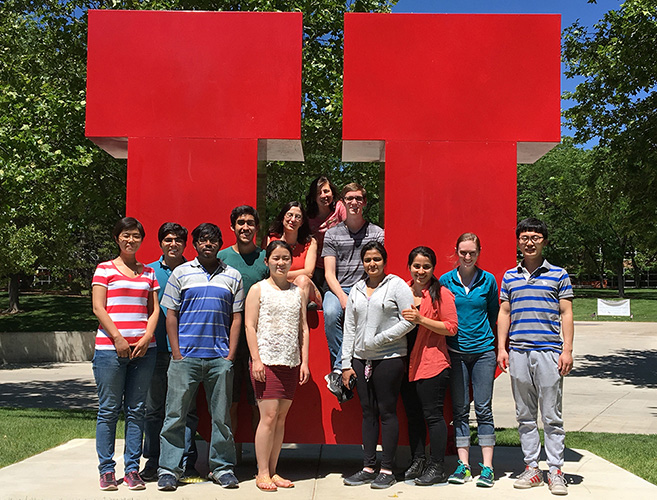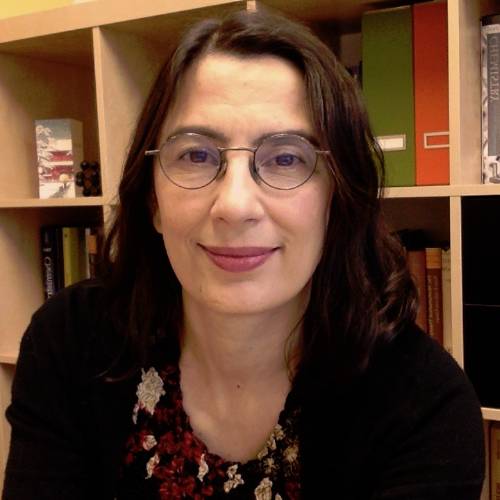
Computer Modeling with Valeria Molinero
Professor Valeria Molinero doesn’t really remember how she first decided to study chemistry.
“When I was a child, I wanted to be an archaeologist, because I found it fascinating that in artifacts, you could discover the mysteries of the past.” But then she started taking math classes, and she loved math. When she started taking physics classes, she loved physics. And when she started taking chemistry classes, she loved chemistry. By the time Molinero was starting college, her fascination had evolved to discovering how materials worked, not what they revealed about the past.
She completed her undergraduate and doctoral degrees at the University of Buenos Aires in Argentina, studying electrochemistry as an undergraduate, then statistical mechanics and computer simulations as a graduate student. She loved both of these areas of chemistry (surprise!).
“I actually like everything,” Molinero joked.
When she moved to Caltech for a postdoctoral position, Molinero got a sense of how molecular simulations can be used to address more complex problems. Her first project was supported by Kellogg’s. The goal was to use computer simulations to make crispier cornflakes. She also worked on modeling materials for fuel cell membranes.
A few years later, Molinero began her independent career at the University of Utah.
“I selected Utah for the amount of sun, I have to confess, and also because of the reputation of the chemistry department. But when I came for my interview, I really felt that it was a welcoming environment. The faculty, the people, the place are all wonderful.”
Besides running her own outstanding research program, Molinero is the Director of the Henry Eyring Center for Theoretical Chemistry. With collaborators in chemistry, biomedical informatics, medicinal chemistry, and materials science, the center is a space to study and discuss advances in the theory of molecular structure and interactions in these fields.
According to Professor Emeritus Jack Simons, the founder of the Henry Eyring Center for Theoretical Chemistry, theory is “a diverse field of chemistry that uses physics, mathematics and computers to help us understand molecular behavior, to simulate molecular phenomena, and to predict the properties of new molecules.”
In computational chemistry, instead of working with real molecules, scientists like Molinero build mathematical models of molecules and their interactions.
“Computer simulations are a way of doing experiments, just within a computer,” she explains. “The role of theoretical and computational chemistry is to provide more insight on how molecules interact and react. It’s very similar to experiments, but cheaper. But they have to complement each other. You can only be sure that your model is right if you predict results of the experiment or you are able to validate with results of existing experiments. ”
Computational chemistry also allows the scientist to do things that might not be possible in a traditional lab. For example, you can look at what’s called a “rare event.” Let’s say you have a glass of water, containing many moles of molecules. If you are looking for the behavior of just a few select molecules, it’s very hard to find them. Computer simulations allow you to see something that is only a few nanometers in scale or happens in just a few nanoseconds. Simulations also enable you to design materials that do not yet exist, and then work with a collaborator to build promising materials.
“In some sense we are like the gods of the elements. We can go beyond what’s accessible, and then other scientists can pick up our work and do something interesting from there,” Molinero said.
Her project on fuel cell membranes is a good example of developing promising materials in models, then testing them with collaborators. The goals of this project are twofold: first, to develop and improve the methods used to model these materials; and second, to identify materials that have promising properties for the transport and the mechanical stability of the membranes.
Another interesting project that shows the diversity of Molinero’s work has to do with understanding how water forms ice, particularly in cloud droplets. Clouds are made of droplets – these droplets nucleate around a particle that has the ability to absorb water such that it is going to favor the formation of a liquid particle. Most of these particles that are hydrophilic can produce a cloud droplet, but only about one in a million of the aerosols that exist in the atmosphere are able to induce the nucleation of ice. Scientists don’t yet know what characteristics of the molecules induce the formation of ice, and this has been the focus of Molinero’s group in the last few years.
“There are different temperatures at which ice can form, depending on how effective the surface is,” she said. “We use molecular simulations, in which we build models of the surfaces present in the atmosphere, to predict these temperatures.”
The existence of water in the atmosphere, and what state it is in, controls Earth’s energy budget, or the flow of incoming and outgoing energy in the Earth’s climate system. When you have liquid water in the atmosphere, there is more absorption of radiation. When you have ice, there is more reflection of radiation. We can only predict the flow of this energy by knowing the temperatures at which different atmospheric aerosols can induce ice formation.
“This research is important for the accuracy of climate prediction models, which use set parameters for the density and type of aerosols,” Molinero explains. “The more we understand how different types of aerosols form clouds and form ice, the better our climate predictions models will be.”
What ties all of Molinero’s diverse research together is her search to find simplicity in complex behavior.
“I like systems and questions that look complicated, but when you understand them, you see they are governed by a few rules,” she said. “But to complete the picture you need a lot of people thinking, questioning your work, putting forward new hypotheses, and making mistakes that lead to new discoveries. I need the diversity of thinking of my undergraduate students, graduate students, and postdocs. The people who challenge and build on your ideas make science great.”

